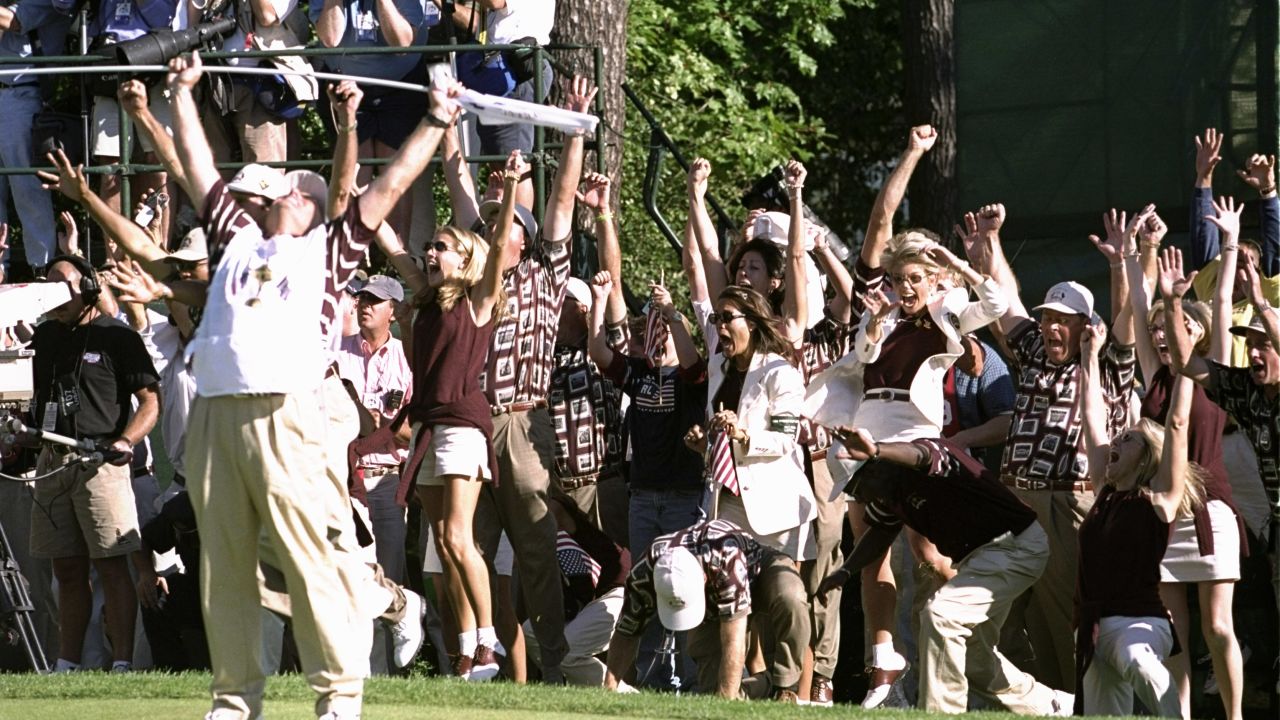Blog
Playing Par 5s: How to Own Them

Here’s the deal, golf lessons can be great. If you take them from a reputable club pro, you may learn a lot about swing mechanics, the plane of your swing, tempo, swing speed and even impact position. However, lessons don’t tell you how to look at a golf hole and assess the risk vs. reward. Simply put, lessons do not get into hole strategy.
So, when you are standing on the tee box on hole 16, a 487-yard par 5 with a 245-yard forced carry AND you are playing the round of your life…what do you do? Your golf buddies are saying things like “You didn’t come this far to lay up“ or “Don’t over think it, just rip driver”. They may be right, but without a plan you are basically throwing darts blind. Nothing hurts more than carding a snowman on a birdie hole and nothing will jack up your score as well as your mental game faster than indecision.
We all hate the dreaded “Big Number” and that’s why we are here for you. So, the next time you are in that spot, remember these 5 tips:
Five keys to owning par 5s:
– Don’t just automatically grab driver – Choose the right club off the tee
– Look at your lie – Assess what shot best suits your approach
– Take an extra club on your approach – 70% of approach shots come up short
– Know where to miss – Do not always go flag hunting
– Have a number in mind to lay up to in case you can’t go after it in two
Many weekend golfers hate par 5s because they are long and can seem daunting. The task: you are basically trying to get a 1 ½ inch ball into a 4-inch hole from 5 football fields away! But they also provide great opportunity if played properly. They are a golden goose for birdies and can turn an 81 into a 79 like that.
1. Select the Right Club on a Par 5

I know you heard me before, but this is a huge mistake I see all the time. You don’t always have to hit driver off the tee. You can hit a fairway wood or a hybrid. Shoot If I know I can not get home in two, I hit my 3 iron all day off the box and more times than not am sitting pretty for my approach while my buddies are ball hunting in the woods. Let’s be honest, it’s probably going to take three shots to reach the green any way unless you can bomb it 300+. So, use the club that gives you the best chance of finding the fairway.
2. Look at Your Lie and Assess The Shot

This is the golden ticket to scoring on Par 5’s. Little known fact: The second shot is often the key to beating par 5s. You need to play a smart shot that puts you in the best position to card a 4. Start by looking at your lie; is it in the fairway or first cut, is it a flier lie or sitting down a little bit, is it side hill above or below your feet? All of these will 100% determine what club you can and should hit. Hitting a 3-wood off a downhill side hill lie in the intermediate rough is hard to do. I suggest you take your medicine and lay up to a good number, so you hit the GIR and have a look at bird.
3. Take an Extra Club
This one is huge. Most approach shots come up short. The average handicap for men is about a 15. The average swing speed is 93 mph and produces a 220 yard drive. Ask around, everyone thinks they hit the ball farther than they actually do. Here are some trackman averages for reference. Take an extra wrench and thank me later. You will hit more greens, score better and find yourself shooting lower scores.
4. Know Where to Miss

Now you hit your drive, you looked at your lie, you have the right club for your approach, time to go flag hunting, right? WRONG. You want to look at the green complex and pin placement. You want to see where the greenside bunkers are. Does the green slope down and away or is there a false front? Start taking note of the danger areas and take them out of play. These determinations will help you pick out a landing area for this shot. For the love of the game, do yourself a favor and stay away from trouble at all costs. Play smart and aim center green. Nobody hit it dead straight every time, well maybe the guys on tour, but even they miss a handful of times per round. This strategy of knowing where not to be, allows you to better understand where to be! It gives you the greatest chance of hitting the green even on a slight miss.
5. Know Your Ideal Lay Up Number

There is no shame in laying up on a par 5. More times than not, smart money says it’s the right move. That’s especially true if the flag is protected by water or a massive pot bunker. Sometimes golfers try to pull off a miracle shot on their second from 237 out in the rough under a tree. They end up in the drink and dropping hitting 4 and will likely post a double bogie when its all said and done. Had they just taken the 5 iron out and laid back to 120 in they would have stuck a 9 iron to 15 feet and a look at 4!
Now I am no PGA tour pro golfer. I am a 5.5 handicap and like the Alice in Wonderland quote “I give myself very good advice, but very seldom follow it” I will tell you, however, that on occasion I stumble onto a pearl and feel the need to pass it on. Use this simple five-step approach above when playing par 5s. It’s a practical golf lesson that can help you own par 5s no matter their length or difficulty. That, in turn, will cut strokes from your scores, lower your handicap and have you collecting the $$$ at the end of the round.
BONUS SCORING DRILL:

Here is Today’s Tip… Your Wedges.
Very few weekend warriors practice hitting wedges at less than full distances. Ironically, however, we face these shots all the time on the course. I know I do. The closer your approach shots the better your chance of draining putts. It’s funny, I always told myself that I was not a great putter. I started doing this drill below and low and behold my distance to the pin was tighter and I started making more putts. Turns out, I was not a bad putter at all, I just was hitting my approach shots to 40 feet. Here’s how I fixed it:
Pick three awkward distances — say 25, 50 and 75 yards… then hit five balls at each target. Now, don’t just grab the 60 for all these shots, actually select the club you would use in a round. Give yourself a point for each ball that lands within what you consider an acceptable distance — I use a 15-foot circle. Max score for this drill is 15 points. Whatever you score, try to beat that number the next day, with the perfect score of 15.
I guarantee if you do this a couple of days in a row, or even for just 15 minutes before your round, you will be stunned at the results on the course. Once you score 15, tighten up that proximity the next time. Pretty soon you will be sending those pitch shots inside a 5-foot circle and have you golf buddies jealous as your ex at your wedding.
Blog
Unveiling the History and Symbolism of Iconic Golf Trophies
Golf is a sport steeped in tradition, prestige, and class. From the lush greens of the course to the meticulously designed clubs, each aspect of the game exudes a sense of history and elegance.

Golf is a sport steeped in tradition, prestige, and class. From the lush greens of the course to the meticulously designed clubs, each aspect of the game exudes a sense of history and elegance. Among these elements, golf trophies – the coveted prizes of the tournament – hold a special place. These iconic awards not only represent the winning golfer’s skill and determination but also carry a rich history and meaningful symbolism. In this article, we’ll delve into the story behind some of the most iconic golf trophies and what they symbolize, offering a unique perspective on this beloved sport.
The Claret Jug: The Open Championship
The Claret Jug, officially known as The Golf Champion Trophy, is awarded to the winner of The Open Championship, one of the four major championships in professional golf. The trophy, first presented in 1873, replaced the original prize of a red leather belt with silver buckle.
Its design is based on the medieval ‘claret jugs’ used to serve wine. The symbolism here lies in the association of the jug with a time-honored tradition, reflecting the essence of the tournament itself. The names of all the previous winners are inscribed on the jug, creating a tangible link to the history of the sport.
The Green Jacket: The Masters Tournament
At The Masters Tournament, one of the most prestigious events in golf, the winner is honored with a distinctive green jacket. The tradition began in 1937 when members of the Augusta National Golf Club wore green jackets to distinguish themselves from the crowd.
The symbolism of the Green Jacket is twofold. Firstly, it represents membership of an exclusive club, as only winners of The Masters or members of the Augusta National Golf Club are entitled to wear it. Secondly, the green color reflects the lush, pristine condition of the golf course, a crucial aspect of the sport.
The Wanamaker Trophy: PGA Championship
The Wanamaker Trophy, awarded to the winner of the PGA Championship, is named after Rodman Wanamaker, who played a significant role in establishing the Professional Golfers’ Association of America. It’s one of the largest trophies in professional golf, standing nearly 2.5 feet tall and weighing 27 pounds.
The size and weight of the Wanamaker Trophy symbolize the magnitude and prestige of the tournament it represents. Moreover, engraved on its silver surface are the names of past champions, honoring the legacy of the game.
The U.S. Open Trophy
The U.S. Open Trophy, awarded to the winner of the U.S. Open, dates back to 1895. The trophy was destroyed in a fire in 1946 and had to be recreated from photographs of the original.
The trophy is a sterling silver cup, adorned with elaborate ornamentation. The names of previous winners are engraved on the base, acknowledging the tournament’s rich history. The trophy represents the pinnacle of achievement in American golf, symbolizing the grit and determination required to prevail in one of the sport’s most challenging competitions.
Golf trophies are more than just symbols of individual triumph; they are embodiments of the rich history, tradition, and enduring spirit of the game. From the Claret Jug’s reflection of time-honored tradition to the Green Jacket’s symbolization of exclusivity and pristine golfing conditions, each trophy carries a unique story and meaning. These iconic awards, while coveted for their prestige, also serve as a timeless reminder of the sport’s enduring allure and the unforgettable moments that define golf history.
Blog
The Most Dramatic Final-Day Finishes in Major Sports Tournaments
Many sports have some nail bitting finishes. Robert Greenfield recaps some major final day finishes in sports history.

The final day of major sports tournaments often delivers an exhilarating end to the competition that keeps fans on the edge of their seats. There’s no better testament to the suspense and drama of sports than those last-minute turnarounds, nail-biting finishes, and underdog triumphs that define the beauty of competition. This article will take you on a thrilling journey through some of the most dramatic final-day finishes in major sports tournaments, reminding us all why we love sports in the first place.
-
- The Miracle of Istanbul – 2005 UEFA Champions League Final
The 2005 UEFA Champions League Final between Liverpool and AC Milan is etched in the annals of football history as one of the most dramatic comebacks ever witnessed. AC Milan, boasting a star-studded lineup, went into halftime with a seemingly unassailable 3-0 lead. However, Liverpool had other plans. In a six-minute spell after halftime, the Reds staged an incredible comeback to level the match at 3-3, eventually winning the game on penalties. The victory was a testament to the never-say-die spirit of Liverpool and the unpredictability of football.
-
- The “Shot Heard ‘Round the World” – 1951 National League Pennant Playoff
In baseball’s history, few moments match the drama of the 1951 National League Pennant Playoff. The New York Giants and the Brooklyn Dodgers were facing off in a three-game playoff to determine the National League champion. In the bottom of the ninth inning of the decisive third game, with the Giants trailing 4-2, Bobby Thomson hit a game-winning three-run homer off Dodgers pitcher Ralph Branca. This legendary moment, known as the “Shot Heard ‘Round the World,” is one of the most iconic in baseball history.
-
- The 1999 Ryder Cup “Battle of Brookline”
The 33rd Ryder Cup, held at The Country Club in Brookline, Massachusetts, saw one of the greatest comebacks in the history of golf. The United States trailed Europe 10-6 heading into the final day, but in a stunning display of determination and skill, the American team clawed back to win 14.5-13.5. The victory, known as the “Battle of Brookline,” is still celebrated as a pivotal moment in golf history.
-
- The 1980 “Miracle on Ice”
One of the most dramatic moments in the history of ice hockey came during the 1980 Winter Olympics. The heavily favored Soviet Union team was expected to sweep the gold, but the underdog United States team had different plans. In a game filled with tension and drama, the U.S. team defeated the Soviets 4-3 in a match now known as the “Miracle on Ice.” This victory is not only iconic in the sport of ice hockey but also a significant moment in American sports history.
- The 2019 Cricket World Cup Final
The final of the 2019 Cricket World Cup between England and New Zealand was filled with unprecedented drama and suspense. Both teams ended their innings tied on 241 runs, leading to a Super Over – cricket’s version of a tiebreaker. Incredibly, the Super Over also ended in a tie, with both teams scoring 15 runs. England was ultimately declared the winner on the basis of a boundary countback rule, marking their first-ever World Cup victory.
Conclusion
The unpredictability, suspense, and drama are what make sports so captivating. These dramatic final-day finishes remind us of the thrilling highs and lows that come with the world of competitive sports. As fans, we live for these moments, cherishing the unexpected triumphs and heartbreaking defeats. The next time you find yourself watching the final day of a major sports tournament, remember these historic moments and brace yourself for the potential drama that could unfold.
Blog
Weather and the Game: The Undeniable Influence of Elements on Championship Outcomes
Learn how weather affects different championship outcomes.

Introduction
As a sports enthusiast, you might have noticed that weather plays a significant role in sporting events, particularly in championships. From the power of a baseball pitch to the course of a golf ball, from the strength of a football kick to the stride of a marathon runner – the elements can influence each of these and more. In this article, we delve into the fascinating intersection of meteorology and sports, examining how weather conditions can make or break a championship game.
The Impact of Weather on Different Sports
Whether it’s football, baseball, golf, tennis, or marathon, each sport faces unique challenges when it comes to weather. Let’s delve into the specifics:
Football and Weather Elements
Football is a sport that’s played in almost all weather conditions except for severe ones like lightning storms. However, weather elements have a significant impact on the game.
-
- Rain: A wet field makes the ball slippery, impacting players’ ability to handle, pass, or kick the ball accurately. Rain can also make the field muddy, affecting the players’ ability to move swiftly.
- Wind: Strong wind can alter the trajectory of the ball, affecting passes and kicks.
- Cold: Extremely cold temperatures can affect players’ physical performance and endurance, while also making the ball harder and more challenging to catch.
Baseball and Weather Elements
Baseball is another sport where weather conditions can significantly influence the outcome.
-
- Wind: The direction and speed of the wind can affect the trajectory and distance a baseball travels.
- Humidity: High humidity can make the ball denser, potentially reducing its bounce and speed.
- Temperature: Low temperatures can make the ball harder, affecting its bounce and the players’ ability to grip and hit it effectively.
Golf, Tennis, and Marathons
Weather conditions play an equally crucial role in golf, tennis, and marathons.
-
- Wind: In golf, the wind can alter the ball’s direction and distance. In tennis, wind can affect ball control, altering serves and volleys.
- Temperature: Extreme heat can affect a marathon runner’s performance significantly, leading to dehydration and exhaustion.
- Rain: In golf, a wet course can slow down the ball, while in tennis, a wet court can make the ball bounce irregularly.
Case Studies: Weather Influencing Championship Outcomes
This section presents some examples of games where weather conditions significantly influenced the outcome.
- The “Ice Bowl” (1967): The NFL Championship game between the Green Bay Packers and the Dallas Cowboys, often referred to as the “Ice Bowl,” witnessed one of the coldest conditions in NFL history, affecting players’ performance and the final outcome.
- The “Windy City” World Series (1945): The World Series game between the Chicago Cubs and Detroit Tigers was so affected by the wind that it changed the trajectory of the baseball multiple times, influencing the game’s final score.
- Wimbledon Championships (2019): The final match between Novak Djokovic and Roger Federer was played with the Centre Court’s roof closed due to rain, limiting the natural elements’ effects and perhaps altering the match’s dynamics.
Conclusion
The impact of weather on sports is an exciting field of study, revealing how the natural elements influence games and championships. From altering the trajectory of a ball to affecting a player’s physical performance, weather can indeed be a game-changer. As fans and enthusiasts, understanding these influences can add another layer of excitement and anticipation to our favorite sports.
So the next time you attend or watch a game, remember to check the weather forecast. It might just give you a sneak peek into the game’s possible outcome!
-

 Product Review6 years ago
Product Review6 years agoThe Perfect Practice Putting Mat Review by Jason Tenzer
-

 Blog4 years ago
Blog4 years agoLoophole Rule Offers PGA Tour Pros a Mulligan
-

 Blog4 years ago
Blog4 years ago2021 Buyer’s Guide: The Top 10 Value Golf Balls For Distance & Feel
-

 Blog5 years ago
Blog5 years agoGolf Marriage Counselor
-

 Blog6 years ago
Blog6 years ago9 Biggest Chokes Of The Past Decade
-

 Product Review6 years ago
Product Review6 years agoTHE ADJUSTABLE IRONS: WALKING STICKS GOLF CLUBS
-

 Blog4 years ago
Blog4 years agoWhat Your Golf Clubs Say About You
-

 Equipment6 years ago
Equipment6 years agoOHK Sports Interview by Jason Tenzer

















